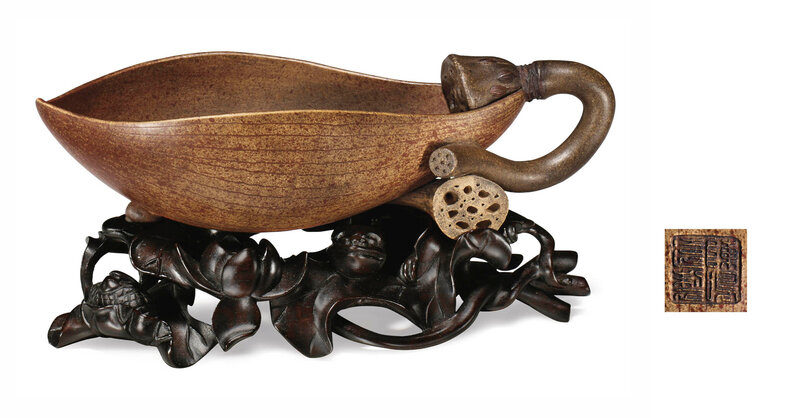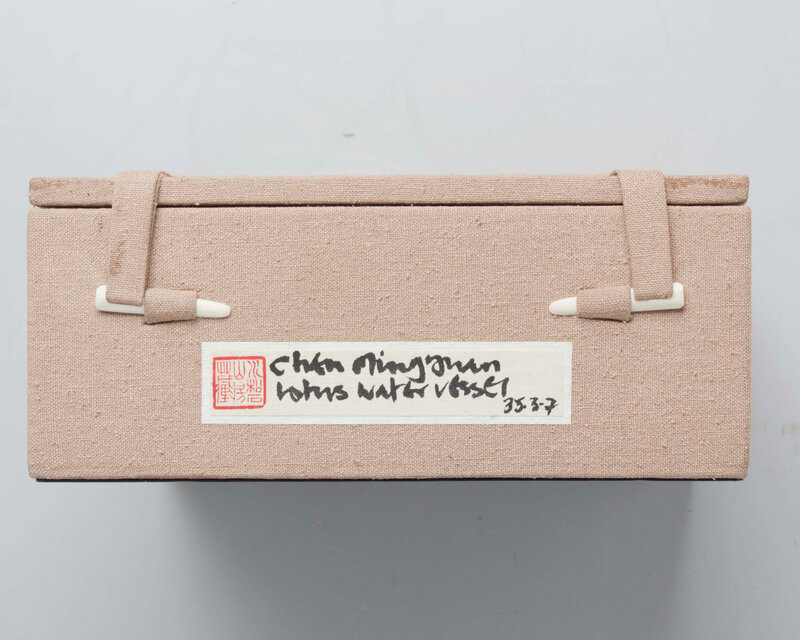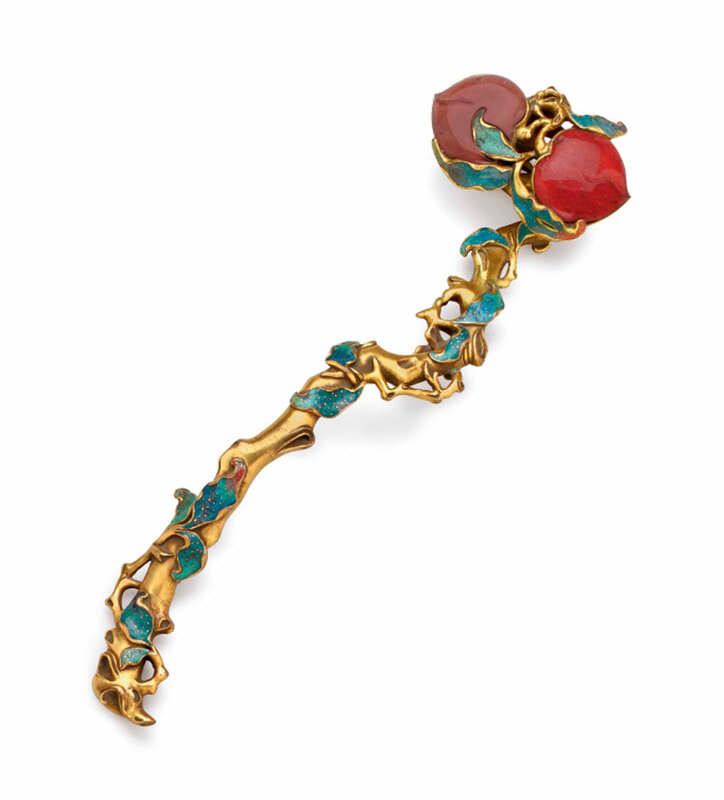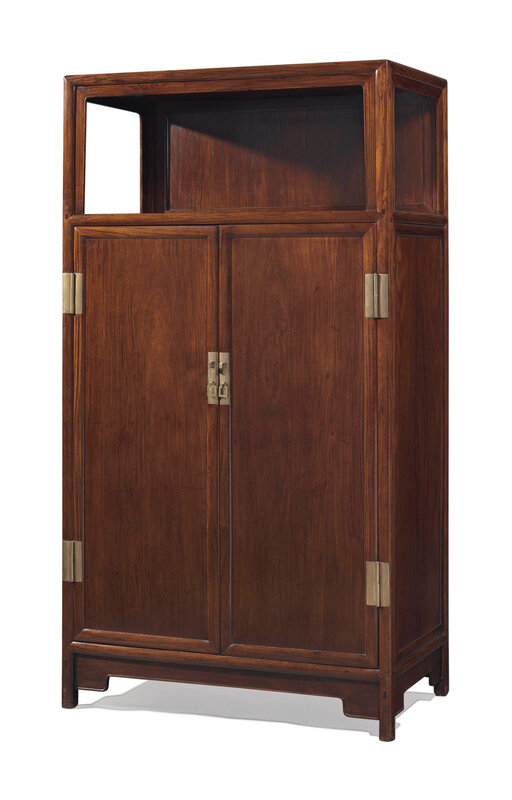The Robert H. Blumenfield collection to be offered @ Christie's Asian Art Week in New York
Lot 1253. A Very Rare Beige Yixing Double Peach-Form Water Pot Signed Chen Mingyuan; 4 in. (10.2 cm.) across. Estimate: $100,000 - 150,000. Price realised USD 386,500. © Christie's Images Ltd 2012
NEW YORK, NY.- On March 22, Christie’s New York will present Auspicious Treasures for Scholars and Emperors: Selections from the Robert H. Blumenfield Collection a single-owner sale of exceptional Chinese carvings, scholar’s objects, ruyi scepters, as well as furniture. Following the success of For the Enjoyment of Scholars in March 2010, Christie’s will offer an additional 137 lots from this renowned collection. Thoughtfully acquired over the past forty years, the Blumenfield Collection ranks among the most significant collections of Chinese scholar’s objects in the world and is expected to realize in excess of $5 million. This sale will be of interest to both seasoned and novice collectors.
Robert H. Blumenfield
Distinguished collector, scholar and author, Robert H. Blumenfield has dedicated his life to the study and appreciation of Asian Art. Mr. Blumenfield has amassed a personal collection that reflects his discerning and distinctive eye, with each object chosen for its rarity and superb quality. Many of the pieces in the collection are unique and exemplify the educated and elegant taste of the Chinese scholar.
Selections from the Robert H. Blumenfield Collection
Lot 1249. An Extremely Rare Yixing Lotus Petal-Form Water Vessel Signed Chen Mingyuan; 5½ in. (14 cm.) long. Estimate: USD 200,000 - USD 300,000. Price realised USD 506,500 © Christie's Images Ltd 2012.
Finely modeled from buff-color clay in the shape of a lotus petal incised with veins on the exterior and borne on a curved stem that also bears a pod at the rim and rests atop a section of rhizome that along with a small snail at the opposite end forms the supports, the lotus petal subtly speckled with red slip, the stem, pod and rhizome covered in greyish-brown slip and the snail of dark brown color, with a zhuanshu seal, Chen Mingyuan zhi, stamped in relief on the base, wood stand, box
Provenance: I-Hsing Wares: Property from a Private Collection, Sotheby's, Hong Kong, 24 May 1978, lot 342.
Shuisongshi Shanfang Collection.
Literature: K.S. Lo, The Stonewares of Yixing from the Ming Period to the Present Day, Hong Kong, 1986, p. 221, no. 143.
Sydney L. Moss Ltd., The Literati Mode, London, 1986, pp. 228-9, no. 104.
Lai Suk Yee and Terese Tse Bartholemew ed., Themes and Variations: The Zisha Pottery of Chen Mingyuan, Shanghai Museum and Art Museum, The Chinese University of Hong Kong, 1997, p. 114, fig. 2.
Exhibited: Yixing Pottery, Hong Kong Museum of Art, 7 October - 13 December 1981, p. 90, no. 32.
Note: This exquisite lotus petal vessel bears the seal of Chen Mingyuan, who was active during the Kangxi and Yongzheng reigns (mid-17th to early 18th century). Chen Mingyuan was an extremely highly regarded ceramic artist, and indeed is generally regarded as one of the finest of all the Yixing potters, and viewed by many as second only to Shi Dabin. He was also noted for his talents as a calligrapher in a style derived from the calligraphy of the masters of the Sui and Tang dynasties. Chen was a native of Yixing, his father Chen Ziqi had been a distinguished potter and Chen Yuan grew up with the traditions of the so-called 'purple sand'. (Although within his family he was Chen Yuan, he usually signed himself Chen Mingyuan, or used one of several hao, sobriquets. It is widely held that Chen Mingyuan is one of the most accomplished Yixing potters. Not only is his technical skill admired, he also possessed a wonderful creativity and artistry. Chen Mingyuan is particularly known for his ingenious use of natural forms, from teapots to models of fruits and nuts.
The current water vessel is a wonderful example of his creativity, his artistic flair and his consummate technical ability. The bowl of the vessel is made as a single lotus petal, beautifully potted and with the speckling and fine veins painted with great delicacy on the exterior. The handle is composed of a cut lotus stem, which terminates on the interior of the petal with a small lotus pod. The vessel is balanced on a rhizome on one side and a small snail on the other. Each aspect of the design is naturalistically rendered and each complements the others. The use of the single petal is especially interesting, since single lotus leaves have often been used in both ceramics and jade to form covers, ink palettes, and water containers, but a single petal is very innovative. The petal itself is very gracefully rendered, and it is also tempting to see the calligrapher's eye in the fluid lines of the petal's edge and the curvature of the handle, while the delicacy of the slip painted details also provide a testament to fine brush control.
A similar vessel from the collection of I.M. Pei is illustrated by Teresa Tse Bartholomew in I-Hsing Ware, China House Gallery, China Institute in America, 28 October 1977 - 29 January 1978, p. 61, no. 37. Another is illustrated by Helen Comstock, "Some Examples of I-hsing Pottery," Connoisseur, Vol. CIV (March 1942), p. 75.
Lot 1228. A Rare Glass-Inlaid and Enamel-Decorated Gilt-Bronze Ruyi Scepter, Qianlong Period (1736-1795); 12¾ in. (32.4 cm.) long. Estimate: $70,000-90,000. Price realised USD 86,500. © Christie's Images Ltd 2012.
Finely cast in the form of a gnarled, leafy branch bearing two glass peaches at one end to form the head of the scepter, the peaches of rosy pink and greyish-pink color, while the leaves are in green, blue and dark red enamel speckled with gold dots.
Provenance: Christie's, Amsterdam, 2 May 2007, lot 421.
Note: Elegantly and naturalistically cast as a fruiting branch, the present scepter is a dazzling testament to the skill of the Chinese craftsmen during the Qianlong period.
Two very similar scepters, with hardstone rather than glass peaches, have been sold by Christie's, one in our Paris rooms, 13 June 2007, lot 89 and another in our Hong Kong rooms, 3 November 1998, lot 1053, which was illustrated by Lin Shwu-shin, The Jade-Carving Art in the Ch'ing Dynasty, Taipei, 1996, pp. 128-9. It is possible that these scepters would have originally belonged to a set of three, including one with pomegranates and one with finger citrons, thereby representing the sanduo. Such a set was sold at Sotheby's Hong Kong, 22 May 1979, lot 296.
Lot 1274. An Extremely Rare Imperial Small Songhua Ink Palette, Box and Cover, Qianlong period, ink palette with Qianlong carved four-character seal mark and of the period (1736-1795). Ink palette 2½ in. (6.4 cm.) long, box 2 7/8 in. (7.2 cm.) long. Estimate: $300,000-500,000. Price realised USD 362,500. © Christie's Images Ltd 2012.
The green ink palette of irregular shape carved in relief with a dragon emerging from waves in the well above the grinding surface, the seal mark carved on the underside, the box and cover of conforming outline, the cover finely carved in relief through the ivory and soft green outer layers to the purplish-brown stone with two rabbits in a setting of chrysanthemums, rocks and bamboo, cloth box
Provenance: Collection of Mrs. Velma Sun, Los Angeles.
Erica Phillips, Los Angeles.
Exhibited: Sumptuous Elegance: Art of the 18th Century Qing Dynasty, Los Angeles County Museum of Art, 17 March - 30 May 1992.
Note: This exquisite little Songhua stone ink palette is not only exceptionally finely carved, but also bears decoration with a wealth of auspicious symbolism and compliments to the emperor. On the interior of the palette a dragon is shown rising from the waves. This is a very appropriate symbol for the emperor. The five-clawed dragon was the imperial symbol, and indeed the emperor was often referred to in terms of a dragon - for example his face would be referred to as 'the dragon's face.' The emperor was also seen as the link between the earth and Heaven and was responsible for the welfare of the empire. An important annual imperial ritual conducted in the third lunar month in the grounds of the Xiannongtan (the Temple and Altar of Agriculture, dedicated to Shen Nong, who is regarded as China's first farmer) required the emperor to personally plough three furrows and to witness princes and high officials ploughing further furrows in order to ensure a bountiful harvest. The Qianlong Emperor is depicted performing this ceremony in an engraving of 1783-88 by Isidore Stanislas Helman, executed from a painting belonging to the French minister Henri-Leonard Bertin, illustrated in From Beijing to Versailles - Artistic Relations between China and France, Hong Kong, 1997, pp. 248-9, no. 95. The dragon inside the current ink palette is also depicted preparing to ensure a bountiful harvest. It is shown rising from winter hibernation among the waves at the spring equinox in order to bring the rain necessary to water the crops.
While the symbolism of the interior of the ink palette refers to Spring, the symbolism of the decoration on the upper surface of the cover refers to Autumn. The main feature of this decoration is two rabbits or hares which are depicted in very lifelike poses. The color of the natural stone has been skilfully used to ensure that the foremost rabbit, and part of the second rabbit is white. According to Daoist legend, a jade-white rabbit or hare lives on the moon, grinding the elixir of immortality with a pestle and mortar. The elixir was believed to have been stolen from her husband, the archer Yi, by Lady Chang E, who fled with it to the moon. However, a Buddhist story provides another explanation of how the rabbit came to live on the moon. The Buddha arrived in a forest, exhausted and hungry after many days of traveling. All the animals came to him bringing the foods that they usually gathered for themselves. The rabbit intended to bring fresh green grass and leaves, but when he found them, he ate them himself. The rabbit was consumed by guilt and going to the Buddha admitted his folly and offered that the Buddha could eat him instead. The Buddha was so touched by this gesture that he bestowed upon the rabbit the gift of eternal life on the moon. Rabbits are therefore associated with long life.
A painting by the court artist Leng Mei (active 1696-1745) preserved in the Palace Museum, Beijing, depicts two white rabbits in very similar poses to those on the current ink palette illustrated by Zhang Hongxing in The Qianlong Emperor - Treasures from the Forbidden City, Edinburgh, 2002, p. 117, no. 61. As on the current ink palette, in the Leng Mei painting the rabbits are shown with chrysanthemums, the flowers of Autumn, since both are associated with the Mid-Autumn Festival, which takes place on the fifteenth day of the eighth lunar month. Both the painting and ink palette also include rocks, which are symbols of longevity, but while the painting shows the rabbits with a wutong tree and blossoming osmanthus, also associated with the rabbit's existence on the moon, the ink palette has bamboo. The bamboo was undoubtedly chosen as a compliment to the emperor, since it symbolizes moral integrity, and is often particularly applied to the scholar, who may bend with the wind of adversity but who will never allow his principles to be broken.
Lot 1323. An Unusual Large Huanghuali Square-Corner Display Cabinet, Wanligui, 17th century; 75 in. (190.5 cm.) high, 41¾ in. (100.6 cm.) wide, 22 in. (55.8 cm.) deep.. Estimate: $200,000 – 300,000. Price realised USD 458,500. © Christie's Images Ltd 2012.
With attractively figured panels set within narrow frames with rounded edges, those on the sides and back of removable type set within the cabinet frame, the doors fitted flush and opening to reveal the shelved interior with two drawers, beneath the upper display shelf framed by plain, beaded aprons and spandrels, all raised on thick legs flanking shaped, beaded aprons
Provenance: Hei Hung Lu, Hong Kong.
Note: The present cabinet is highly unusual, as its method of construction involves the inclusion of removable side and back panels. Cabinets of this type appear to be rare, as on most examples ofwanligui, the side and back panels are fixed in place and cannot be removed. An example of this latter type is illustrated by Wang Shixiang in Connoisseurship of Chinese Furniture: Ming and Early Qing Dynasties, vol. II, Hong Kong, 1990, p. 147, no. D15. Compare, also, the pair ofhuanghuali display cabinets, also of this latter type, from the collection of Dr. S.Y. Yip, sold in these rooms, 20 September 2002, lot 12.
Lot 1246. A Very Rare Yixing Slip-Decorated Brush Pot, signed Yang Jichu, Qianlong period (1736-1795); 6 in. (15.2 cm.) high, 6 1/8 in. (15.5 cm.) diam. Estimate: $200,000 – 300,000. Price realised USD 362,500.© Christie's Images Ltd 2012.
Finely decorated in various colors of slip in imitation of ink painting with a continuous landscape of two figures in a boat approaching a shore where buildings are nestled amidst trees, with pine tree-dotted hills and mountains in the distance, all in shades of dark and pale grey, soft brown and white on a beige body, with a maker's seal, Yang Jichu, stamped in relief on the slightly recessed base .
Provenance: Hugh Moss, London.
Literature: G. Tsang and H. Moss, Arts from the Scholar's Studio, Oriental Ceramic Society, Hong Kong, 1986, pp. 142-3, no. 112.
Exhibited: Yixing Pottery, Hong Kong Museum of Art, 17 October - 13 December 1981, p. 133, no. 73.
Note: The surface of the vast majority of Yixing wares simply displays the body material of the vessel with molded, carved or applied decoration. Glazing or surface painting are rare. A small number of Yixing wares are glazed, usually with a robin's egg glaze, as in the case of a square 18th century teapot in the K.S. Lo collection illustrated in Yixing Purple Clay Wares, Hong Kong, 1994, p. 81, no. 33, or a Jun-type glaze, as in the case of a small Kangxi seal-paste box in the Percival David Foundation illustrated by R. Scott in For the Imperial Court - Qing Porcelain from the Percival David Foundation of Chinese Art, Singapore/London, 1997, p. 107, no. 38. Painted decoration is particularly rare and may take the form of enameled decoration like that of a 19th century teapot in the K.S. Lo Collection illustrated in Yixing Purple Clay Wares, op. cit., p. 109, no. 64. Much more in keeping with the literati aesthetic, however, is the subtle and refined painting in natural slip colors seen on the current brush pot. The landscape on this brush pot mirrors that seen in contemporary literati painting on paper or silk, and indeed both the subject and the layout of the landscape mirror that of a hand scroll.
One difference from the hand scroll layout is that the artist's seal appears not on the 'painting' itself, but on the base of the vessel. The name of the artist is Yang Jichu, who is recorded inChongkan jingxi xianzhi (The Republished Jingxi Gazetteer) compiled by Tang Zhongmian during the Qing dynasty. Yang is noted as being active during the same period as Chen Hanwen, mid 17th-early 18th century. Like Chen Hanwen, Yang Jichu is famous for his work on Yixing wares, especially those, like the current brush pot, which are painted in colored slips.
Several slip-painted brush pots decorated in a similar painterly style with landscapes are preserved in the Palace Museum, Beijing, and are illustrated in The Complete Collection of Treasures of the Palace Museum - Purple Sandy Ware, Beijing, 2008, pp. 141-8. Two of these Palace Museum examples bear the seal of Yang Jichu - one of them (no. 116) has a beige body (Fig. 1), similar to that of the current example, while the other (no. 115) is made from dark brown clay. Both are dated to the Qianlong period, as is another stylistically similar example without a seal mark, which is also in the collection of the Palace Museum (illustrated ibid., no. 114). Interestingly, the Beijing Palace Museum also has a brush pot painted in similar style with a scholar seated in a thatch-roofed pavilion overlooking a lake beside a willow tree which bears a Qianlong mark, illustrated ibid., no. 113. (Fig. 2) A brush pot almost identical to the latter, with a Yang Jichu seal, rather than a Qianlong mark, from the Mr. and Mrs. Gerard Hawthorn Collection was sold at Bonhams, Hong Kong, 28 November 2011, lot 208. Yixing brush pots with slip-painted landscape decoration on a dark ground and bearing the seal of Yang Jichu are preserved in the collections of both the Suzhou Museum and the Yangzhou Museum illustrated in Zhongguo taoci quanji -23 -Yixing, Tokyo and Shanghai, nos. 24 and 70, respectively. A brush pot decorated with pavilions and trees on a dark ground, illustrated in Yangxian Shaqi Jingpin Tupu, Taipei, 1985, pl. 40, also bears a Yang Jichu mark, while a brush pot of this type painted with flowers and rocks, with a Yang Jichu mark, formerly in the Wellington Wang Collection, was sold at China Guardian, Beijing, 21 November 2010, lot 2167.
Lot 1253. A Very Rare Beige Yixing Double Peach-Form Water Pot Signed Chen Mingyuan; 4 in. (10.2 cm.) across. Estimate: $100,000 - 150,000. Price realised USD 386,500. © Christie's Images Ltd 2012
Finely modeled as two peaches, one halved and one whole, joined by a pierced, common wall and borne on a gnarled, leafy branch, the halved peach forming a receptacle applied on the interior wall with a peach stone of reddish color that is pierced to allow water to flow in from the adjoining whole peach reservoir that has a small aperture incorporated into the top of the branch, the bottom of the whole peach, the bottom of the branch and a small peach applied to the bottom of the receptacle forming the supports, the tips of all three peaches finely speckled in reddish slip to suggest the 'blush' of ripeness, with two zhuanshu seals, Chen and Mingyuan, stamped in relief on the lower side of the whole peach, boxx.
Provenance: Private American collection.
Note: The form of this elegant water pot as two peaches attached to a branch with a peach stone inside the open fruit was carefully chosen both for its symbolic meaning and as a demonstration of technical ingenuity. Peach trees have a sacred connotation in China and in ancient times the wood of the peach tree was used as a charm against evil. Thus, the branch of this water pot serves both as a representation of the tree, and as a naturalistic feature joining the two peaches. The peaches themselves are symbols of longevity, and the fact of there being two of these fruit doubles the wish. The association of peaches with longevity arises from the fact of their being symbols of the Star God of Longevity Shou Lao, and linked with the legend of the peaches which grew in the orchard of Xiwangmu, the Queen Mother of the West. These latter peaches took three thousand years to ripen, but conveyed immortality on anyone who ate them. Items decorated with or in the form of peaches were a popular birthday gift in the Ming and Qing dynasties. Small items for the scholar's table in the form of a single peach or two peaches, or indeed two lichees - another auspicious fruit - were especially popular in the 17th and 18th centuries. A number of examples of water pots in the form of two peaches are known in jade and in Jingdezhen porcelain, while a small Wanli porcelain perfume holder made in the form of a whole and a half lichee joined by a leafy stem is in the collection of the Percival David Foundation illustrated by R. Scott and R. Kerr in Ceramic Evolution in the Middle Ming Period, London, 1994, p. 36, no. 75.
This water pot bears the seals of Chen Mingyuan, who was active during the Kangxi and Yongzheng reigns (mid-17th to early 18th century). Chen Mingyuan was an extremely highly regarded ceramic artist, and indeed is generally regarded as one of the finest of all the Yixing potters, and viewed by many as second only to Shi Dabin. He was also noted for his talents as a calligrapher in a style derived from the calligraphy of the masters of the Sui and Tang dynasties. Chen was a native of Yixing, his father Chen Ziqi had been a distinguished potter and Chen Yuan grew up with the traditions of the so-called 'purple sand'. (Although within his family he was Chen Yuan, he usually signed himself Chen Mingyuan, or used one of several hao, sobriquets). It is widely held that Chen Mingyuan is one of the most accomplished Yixing potters. Not only is his technical skill admired, he also possessed a wonderful creativity and artistry. Chen Mingyuan is particularly known for his ingenious use of natural forms, from teapots to models of fruits and nuts.
Chen Mingyuan's skill in carving nuts from Yixing clay is well attested by the group of nuts in the K.S. Lo collection illustrated in Yixing Purple Clay Wares, Hong Kong, 1994, pp. 71-73, nos. 21-24. The peach stone in the current water pot displays equal artistic skill, while serving both to add to the naturalistic appearance of the vessel as a whole, and as an ingenious device to provide a conduit through which small amounts of water could be transferred from the reservoir in the closed peach to the well of the open peach.
Yixing double water pots of this type inspired by organic forms and bearing the seal or seals of Chen Mingyuan appear to be relatively rare. An Yixing water pot of similar color and of double pomegranate form was sold at Sotheby's, Hong Kong, 11 October 2011, lot 2019. A double peach water pot similar to the present example, but lacking the small peach-form support, impressed with a zhuanshu seal, reading 'Shouwen' (an apparently unrecorded seal), from the Mr. and Mrs. Gerard Hawthorn Collection, was sold at Bonhams, Hong Kong, 28 November 2011, lot 270.
Auction: Auspicious Treasures for Scholars and Emperors: Selections from the Robert H. Blumenfield Collection March 22 at 10 am
Viewing: Christie’s Rockefeller Galleries March 16-23

/https%3A%2F%2Fprofilepics.canalblog.com%2Fprofilepics%2F1%2F0%2F100183.jpg)
/https%3A%2F%2Fstorage.canalblog.com%2F03%2F02%2F119589%2F96711876_o.jpg)
/https%3A%2F%2Fstorage.canalblog.com%2F11%2F31%2F119589%2F94773502_o.jpg)
/https%3A%2F%2Fstorage.canalblog.com%2F20%2F83%2F119589%2F94772815_o.jpg)
/https%3A%2F%2Fstorage.canalblog.com%2F26%2F72%2F119589%2F75604929_o.jpg)
/https%3A%2F%2Fstorage.canalblog.com%2F59%2F60%2F119589%2F26458628_o.jpg)











/http%3A%2F%2Fstorage.canalblog.com%2F28%2F99%2F119589%2F129640828_o.jpg)
/http%3A%2F%2Fstorage.canalblog.com%2F13%2F01%2F119589%2F129640604_o.jpg)
/http%3A%2F%2Fstorage.canalblog.com%2F13%2F54%2F119589%2F129640437_o.jpg)
/http%3A%2F%2Fstorage.canalblog.com%2F55%2F89%2F119589%2F129639937_o.jpg)